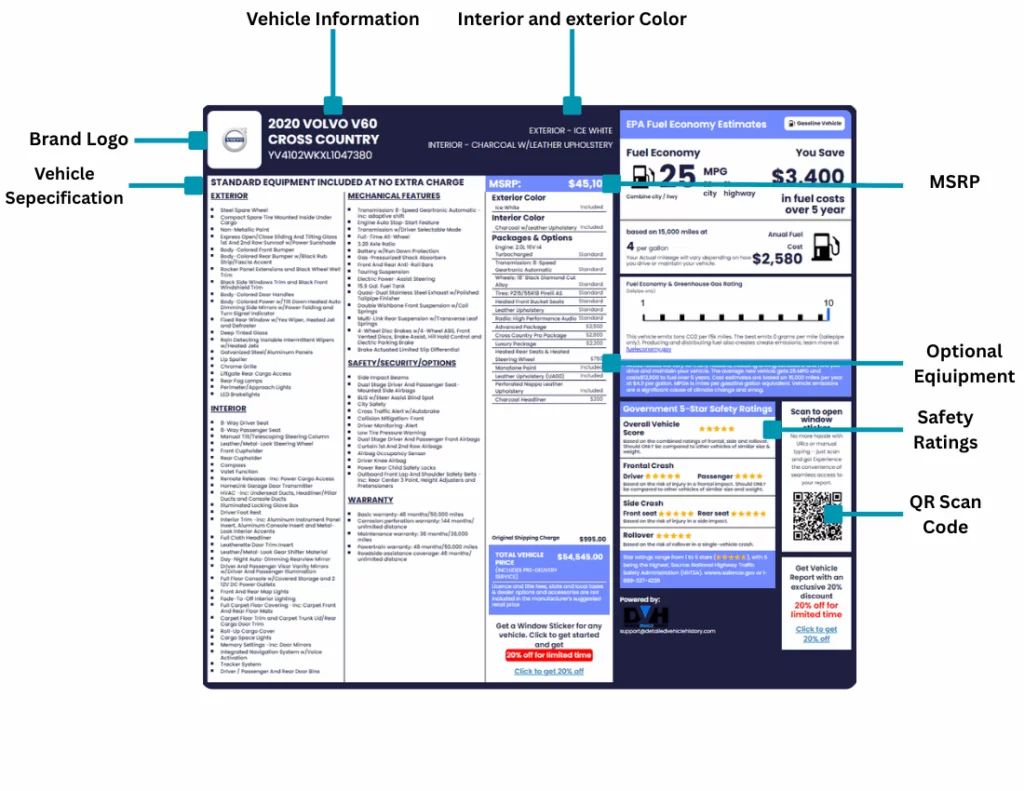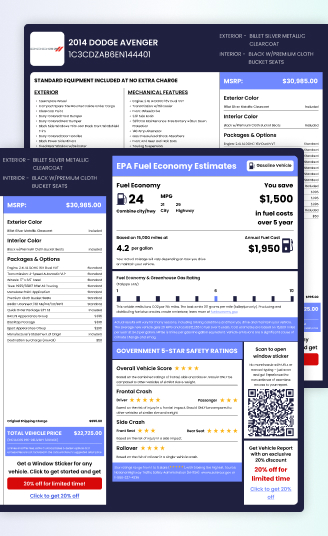Check Car Options by VIN
Instantly verify the trim, options and packages, MSRP, upgrades, and other essential features specific to your vehicle.
What are Car Options and Packages?
Car options are individual features or upgrades added to a vehicle, such as heated seats, sunroofs, or advanced safety systems. Packages group related options together, like a technology or sport package, offering convenience and cost savings. These allow buyers to customize their cars to match preferences, enhancing comfort, performance, and functionality beyond the standard base model.
Here are some examples:

Performance Options
Turbocharged or supercharged engines
Upgraded suspension systems
Sport or off-road packages
High-performance brakes

Safety Features
Blind-spot monitoring
Adaptive cruise control
Lane-keeping assist
Automatic emergency braking

Exterior Options
Alloy wheels or custom rims
Sunroofs or panoramic roofs
Spoilers or aerodynamic kits
Specialty paint finishes or wraps

Interior Options
Premium leather seats
Heated and ventilated seats
Ambient lighting
Upgraded sound systems

Tech and Convenience
Touchscreen infotainment systems
Apple CarPlay or Android Auto
Wireless charging pads
Remote start systems
Extended warranty

Packages
Winter packages with heated seats
Technology packages with advanced infotainment
Towing packages with hitch and cooling systems
What is a VIN and Why Is It Important?
A VIN (Vehicle Identification Number) is a unique 17-character code that identifies a car. It works like a fingerprint for vehicles. An example of a VIN is 1FT7W2BT9MEC68103 which codes for a 2021 Ford F-250. This decoding can be achieved within seconds using our free VIN decoder.
You can find the VIN on the dashboard near the windshield, driver’s door frame, or engine bay. Without the car, check the registration papers, insurance documents, or vehicle title.
A car VIN is key in identifying its original specifications, features, options, and packages, ensuring correct parts, repairs, and resale value. By running a VIN number check, it also helps track accidents, thefts, and recalls, protecting buyers from fraud.
Importance of Checking Car Options by VIN

Verifying a car vehicle history, especially for options by VIN ensures accuracy in features, preventing misinformation. It helps buyers confirm specifications, and make informed decisions when purchasing or valuing a car. Here are other reasons:
Ensures Accuracy in Features: Checking car options by VIN guarantees that the listed features match the original manufacturer specifications. This prevents misleading claims and ensures buyers get the exact features they expect.
Helps Avoid Fraud: Fraudulent sellers may misrepresent a vehicle’s features to increase its value. Looking up the options reveals the true specifications, helping buyers detect discrepancies and avoid potential scams or misrepresented vehicles.
Aids in Proper Valuation: Knowing the exact features and options of a car helps determine its true market value. Buyers and sellers can price the vehicle accurately based on its actual options rather than assumptions or misleading descriptions.
Supports Insurance and Financing Decisions: Insurance companies and lenders use the VIN information to assess a car’s value and risk. Accurate option verification ensures fair insurance premiums and financing terms based on the vehicle’s actual specifications.
- Enhances Resale Confidence: When selling a car, verifying its options by VIN provides transparency to potential buyers. This builds trust, speeds up transactions, and ensures a fair deal based on documented features.
How to Find Your Car Options and Details
To retrieve accurate information on a car’s options and other details like color, MSRP, fuel economy, warranty and more, simply get the vehicle window sticker by VIN, plate or the year, make, and model.
Ready to perform a window sticker lookup? Follow these simple steps:
- Head to the form above, and enter your VIN, license plate, or year, make & model.
- Click on “Search VIN”, “Search License Plate” or “Search YMM.”
- Preview the basic information like the year, make, model, engine details for free.
- Make the little payment to generate a copy of the original window sticker PDF which has all the details to know about the car.
FAQ About Car Options & Packages
What’s the difference between trim levels and option packages?
Trim levels are predefined versions of a car model, each with a set combination of features. Options, on the other hand, are the individual add-ons or upgrades you can choose to customize your car further.
Can I look up my car options by VIN?
Yes! The VIN (Vehicle Identification Number) acts like a bank for obtaining information specific to each car. By decoding the VIN, you can retrieve the original factory-installed options, trim level, and other manufacturing details.
How can I find the trim of my car by VIN?
Use our free VIN decoder to verify your car trim level. It’s a quick and easy way to identify the exact configuration of your car.
How do I know what package my car has?
To know what options and packages your car has, decode the car using our window sticker lookup tool. The VIN contains information about your vehicle, including its trim level and installed options, and all these and more are captured in the car window sticker.
How do I find out what optional extras my car has?
You can check for optional extras by getting a copy of the original window sticker by VIN, license plate or entering the year, make and model. This detail the factory-installed features and packages for your car.
Having this information at your fingertips can make all the difference when buying, selling or restoring your car.

